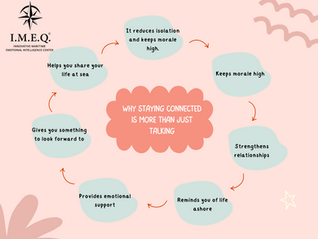Seafarers' Guide to Navigating the Mental Waves of Piracy
- IMEQ CENTER

- Sep 20, 2023
- 4 min read

Preparing seafarers mentally for situations involving piracy or other hostile events is a critical aspect of maritime safety and well-being. Due to the unpredictable nature of such encounters, mental preparation plays a significant role in ensuring that seafarers react optimally under pressure.
Shipping Companies' Role:
First and foremost, shipping companies have the responsibility to equip their crew with the necessary training. Regular training sessions and drills that accurately simulate piracy or hostile situations are indispensable. These activities provide hands-on experience, helping seafarers familiarize themselves with protocols, thereby reducing panic during real-life incidents. Moreover, the provision of updated information is crucial. Seafarers should be informed about high-risk areas, recent piracy incidents, and the nature of prevalent threats, so they are not caught off guard.
Furthermore, mental well-being is as critical as physical safety. Shipping companies should consider offering pre-departure counseling sessions, especially when voyaging through known high-risk areas. Such sessions, conducted by professional counselors, can offer coping mechanisms and techniques to handle stress, fear, and uncertainty. Post-incident support is equally vital. Following a piracy event, immediate counseling, debriefing, and extended support should be available to help crew members process trauma and minimize long-term psychological impacts.
Safety measures also play a role in mental preparation. A ship that is adequately fortified with anti-piracy tools, alarms, and designated safe rooms (or citadels) offers a sense of security. Such infrastructural preparedness can be a source of mental comfort, giving the crew confidence that they have tangible defenses against threats.
Seafarers' Role:
On the individual front, seafarers can take proactive measures to ensure their mental readiness. Engaging wholeheartedly in provided training sessions and drills is a starting point. The adage "practice makes perfect" holds here; repeated engagement in simulated hostile scenarios builds mental resilience and muscle memory for potential real-life events.
Building and maintaining strong interpersonal relationships among crew members is also vital. In times of crisis, a cohesive and trusting team can offer mutual emotional and practical support. These bonds can act as a psychological safety net during high-stress situations.
Personal coping strategies can make a marked difference. Seafarers can invest time in learning and practicing techniques like deep breathing exercises, meditation, or even mental visualization of action plans. Such strategies can serve as immediate tools to combat escalating stress or panic.
Lastly, after an incident, it's crucial for seafarers to engage in self-care and reflection. Processing the events, discussing them with peers or professionals, and seeking therapeutic intervention if needed can promote healing and resilience.
In conclusion, preparing mentally for piracy or hostile situations is a collaborative effort between shipping companies and seafarers. While it's impossible to eliminate all risk, a comprehensive approach to mental preparation and support can significantly reduce the trauma and long-term effects of such encounters.
Knowledge is the key: Here is what you need to know about preventing piracy onboard!
Preventing piracy onboard ships requires a multi-faceted approach that combines proactive measures, security protocols, technology, and international cooperation. Here are some specific solutions to enhance anti-piracy measures:
Vessel Hardening:
Strengthening access points like doors, windows, and hatches to make unauthorized entry more difficult.
Installing barbed wire or razor wire along the ship's sides to prevent boarding.
Using water cannons or fire hoses to repel attackers.
Use of Technology:
Installing advanced radar and surveillance systems to detect approaching boats or threats early.
Employing long-range acoustic devices (LRAD) that emit painful sound waves to deter pirates.
Using drones for aerial surveillance around the vessel.
Best Management Practices (BMP): Adhering to the BMP for protection against piracy, which includes guidelines on speed, route selection, and watch-keeping.
Safe Routes and Reporting:
Avoiding known piracy hotspots when planning routes.
Using secure corridors patrolled by naval forces, especially in high-risk areas.
Regularly reporting the ship's position and status to regional reporting centers.
Employing Armed Guards: While controversial, some shipping companies have opted to use private security teams with specialized training to deter and combat pirate attacks.
Training and Drills: Providing crew members with regular training on anti-piracy measures, including evasive maneuvers and protocols during an attack.
Communication Systems: Ensuring that communication equipment is always functional and that the crew is trained to send distress signals promptly. Satellite phones should be available in case of communication system failures.
Citadels: Designing a fortified safe room onboard, stocked with provisions and communication devices, where the crew can retreat to and stay protected during a pirate boarding.
International Collaboration: Collaborating with international naval forces, such as those provided by NATO or the European Union, which often patrol high-risk waters and offer assistance during pirate attacks.
Tracking Systems: Using AIS (Automatic Identification System) and other tracking systems to monitor ship movements and provide real-time data to relevant authorities.
Increased Vigilance: Enhancing watchkeeping routines, especially when navigating through known piracy-prone zones.
Liaison with Local Authorities: Before accessing ports in piracy-prone regions, liaise with local law enforcement or naval forces for information or assistance.
Community Engagement: Engaging with coastal communities in piracy-prone areas to foster better relationships and gather intelligence on potential threats.
Preventing piracy requires the combined efforts of ship operators, crew members, governments, international organizations, and even local communities. Through comprehensive strategies, continuous training, and the judicious use of technology, the threat of piracy can be significantly minimized.





































































































Comments